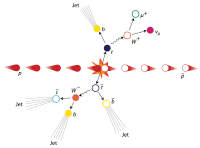كوارك قمي: الفرق بين النسختين
تحت الترجمة |
(لا فرق)
|
نسخة 18:33، 12 ديسمبر 2009
هذه مقالة أو قسم، تخضع لتحريرٍ مُكثَّفٍ في الفترة الحالية لفترةٍ قصيرةٍ. لتفادي تضارب التحرير؛ يُرجى عدم تعديل الصفحة في أثناء وجود هذه الرسالة. أُجري آخر تعديل على الصفحة في 18:33، 12 ديسمبر 2009 (UTC) ( منذ 14 سنة) – . فضلًا أزل هذا القالب لو لم تكن هنالك تعديلات على المقالة في آخر 24 ساعة. إذا كنت المحرر الذي أضاف هذا القالب، فضلًا تأكد من إزالته واستبداله بقالب {{تطوير مقالة}} بين جلسات التحرير. |
لا يزال النص الموجود في هذه الصفحة في مرحلة الترجمة من الإنجليزية إلى العربية. |
| ||||
|---|---|---|---|---|
 عملية اصطدام شارك فيها كوارك قمي |
||||
| التكوين | جسيم أولي | |||
| العائلة | فرميون | |||
| المجموعة | كوارك | |||
| الجيل | ثالث | |||
| التفاعل | كهرومغناطيسية, جاذبية, قوي, ضعيف | |||
| جسيم مضاد | مضاد كوارك قمي ( t ) |
|||
| واضع النظرية | ماكوتو كوباياشي وتوشيهيده ماساكاوا (1973) | |||
| المكتشف | كاشف التصادم في فيرميلاب ومختبر DO التعاوني (1995) | |||
| الرمز | t |
|||
| الكتلة | 173.1±1.3 GeV/c2[1] | |||
| متوسط العمر | 5×10−25 s | |||
| يضمحل إلى | كوارك قعري (99.8%) كوارك غريب (0.17%) كوارك سفلي (0.007%) |
|||
| الشحنة الكهربائية | +2⁄3 e | |||
| شحنة لونية | نعم | |||
| الدوران | 1⁄2 | |||
| قمة | 1 | |||
| لف نظائري ضعيف | 1⁄2 (جهة اليسار) 0 (جهة اليمين) |
|||
| تعديل مصدري - تعديل | ||||
The top quark or t quark (from its symbol, t) is an elementary particle and a fundamental constituent of matter. Like all quarks, the top quark is an elementary fermion with spin-1⁄2, and experiences all four fundamental interactions: gravitation, electromagnetism, weak interactions, and strong interactions. It has an electric charge of +2⁄3 e,[2] and is the most massive of all observed elementary particles. (The Higgs boson, which may be as massive, has not yet been experimentally observed.) It has a mass of 173.1±1.3 GeV/c2,[1] which is about the same mass as an atom of tungsten. The antiparticle of the top quark is the top antiquark (sometimes called antitop quark or simply antitop), which differs from it only in that some of its properties have equal magnitude but opposite sign.
The top quark interacts primarily by the strong interaction but can only decay through the weak force. It almost exclusively decays to a W boson and a bottom quark, but it can also sometimes decay into a strange quark, and on the rarest of occasions, into a down quark. The Standard Model predicts its lifetime to be roughly 5×10−25 s.[3] This is about 20 times shorter than the timescale for strong interactions, and therefore it does not form hadrons, giving physicists a unique opportunity to study a "bare" quark. (All other quarks hadronize, meaning they can only be found in hadrons.) Because it is so massive, the top quark also allows to predict the mass of the Higgs boson under certain extensions of the Standard Model (see Mass and coupling to the Higgs boson below). As such, it is extensively studied as a means to discriminate between competing theories.
Its existence (and that of the bottom quark) was postulated in 1973 by Makoto Kobayashi and Toshihide Maskawa to explain the observed CP violations in kaon decay,[4] and was discovered in 1995 by the CDF[5] and DØ[6] experiments at Fermilab. Kobayashi and Maskawa won the 2008 Nobel Prize in Physics for the prediction of the top and bottom quark, which together form the third generation of quarks.[7]
المصادر
- ^ أ ب C. Amsler et al. (Particle Data Group) (2009). "PDGLive Particle Summary". Particle Data Group. اطلع عليه بتاريخ 2009-07-23.
- ^
S. Willenbrock (2003). "The Standard Model and the Top Quark". في H.B Prosper and B. Danilov (eds.) (المحرر). Techniques and Concepts of High-Energy Physics XII. NATO Science Series. Kluwer Academic. ج. 123. ص. 1–41. ISBN:1402015909.
{{استشهاد بكتاب}}:|editor=باسم عام (مساعدة) - ^ A. Quadt (2006). "Top quark physics at hadron colliders". European Physical Journal C. ج. 48: 835–1000. DOI:10.1140/epjc/s2006-02631-6.
- ^ M. Kobayashi, T. Maskawa (1973). "CP-Violation in the Renormalizable Theory of Weak Interaction". Progress of Theoretical Physics. ج. 49: 652. DOI:10.1143/PTP.49.652.
- ^
F. Abe et al. (CDF Collaboration) (1995). "Observation of Top Quark Production in
p
p
Collisions with the Collider Detector at Fermilab". Physical Review Letters. ج. 74: 2626–2631. DOI:10.1103/PhysRevLett.74.2626. - ^
S. Abachi et al. (DØ Collaboration) (1995). "Search for High Mass Top Quark Production in
p
p
Collisions at √s = 1.8 TeV". Physical Review Letters. ج. 74: 2422–2426. DOI:10.1103/PhysRevLett.74.2422. - ^ "2008 Nobel Prize in Physics". The Nobel Foundation. 2008. اطلع عليه بتاريخ 2009-09-11.


